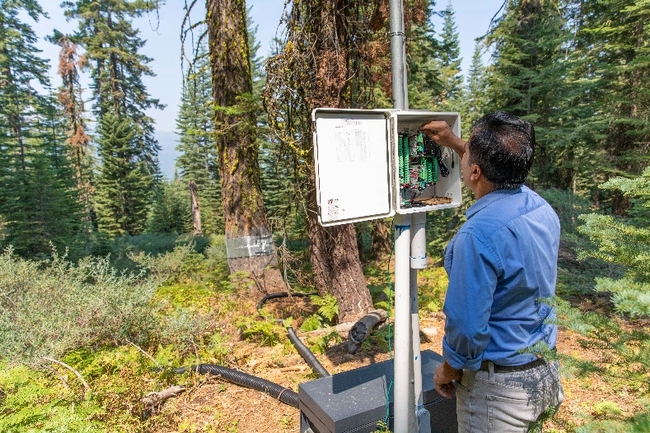French Meadows partnership completes fourth season of work
Safeeq Khan of UC ANR among collaborators on forest treatments in the Sierra
Despite the challenges of an extremely dangerous fire season, including California's largest wildfire in 2022 (Mosquito Fire) impeding access and limiting operations, partners of the French Meadows Forest Restoration Project have wrapped up their fourth season of forest treatments in the critical headwaters of Tahoe National Forest. Safeeq Khan, Cooperative Extension specialist in water and watershed sciences with UC Agriculture and Natural Resources, is among the collaborators.
This season, project partners safely treated over 700 acres of federal land using a combination of mastication, mechanical thinning, hand thinning and prescribed fire. On adjacent private land, the American River Conservancy independently raised funds and treated 338 acres. Combined, this all-lands collaborative watershed management project has treated over 6,000 acres in just four seasons.
Work this season focused on areas most prone to wildfire ignition. The United States Forest Service treated over 200 acres with prescribed pile burns in and around the Talbot campground, improving the aesthetic quality of this important recreation area just north of French Meadows Reservoir. Although dry conditions limited the scope of prescribed burns this year, using fire as a management tool is a cost-effective way to maintain forest conditions that contribute to ecosystem resilience and human health and safety.
“Prescribed burns are a critical component of the partnership's ecological forestry model,” explained Edward Smith, forest ecologist and fuels manager with The Nature Conservancy. “Under ‘prescribed conditions' of wind, moisture and temperature, broadcast burning helps reduce the amount of tinder on the forest floor as well as fuel ladders that could otherwise carry wildfires into the tops of trees, protecting habitat for humans and diverse wildlife species. Fire also reduces brush and twigs to ashes that feeds the roots of trees and understory plants, protecting the soil and its microbial universe, making them more resilient to drought, insects and climate change.”
Mechanical thinning, hand thinning, and mastication operations continued in areas surrounding water research instrumentation, installed by the Sierra Nevada Research Institute at the University of California, Merced. Over the coming years, researchers will be assessing how vegetation changes in ecologically-based forest management affect water quantity in the local watershed.
“Optimal restoration of forested headwaters benefits from dedicated partnerships collecting scientific data,” said Khan, who is also an adjunct professor of civil and environmental engineering at UC Merced. “UC Merced is working to provide this dimension at French Meadows with strategic measurements and modeling.”
Perhaps the partnership's biggest success in 2022 was securing, via multiple grants, the remaining funding necessary to complete all the thinning operations defined in the original project plan. Since the project's inception more than six years ago, the partnership has operated under an innovative funding arrangement consisting of local, state and federal dollars combined with private donations.
“What has impressed me most about the French Meadows partnership is its commitment to see the project all the way through: start to finish,” said Tahoe National Forest Supervisor Eli Ilano. “With the new funding secured this year, we will be able to wrap up thinning operations, and turn our focus to managing and maintaining the land for the enjoyment of the public.”
American River District Ranger Mary Grim with the U.S. Forest Service added, “This partnership learns from each year to adaptively manage for resilient forests that benefit everyone. The French Meadows Project is a reminder of what can be accomplished with a shared sense of stewardship for our forests and natural resources.”
Fuels reduction work this season resulted in more than 1.066 million board feet of overstocked timber, which was brought to a local mill, with the revenue generated offsetting some of the restoration costs. Project partners also repaired over seven miles of roadway and culverts to reduce sedimentation.
“Under the threat of a second consecutive severe fire season, including the Mosquito Fire in our own ‘backyard,' the partnership diligently moved treatment activities forward and began discussions on how to sustain the project's benefits through long-term maintenance planning,” said Kerri Timmer, regional forest health coordinator with Placer County, who coordinates the stewardship agreement with the Tahoe National Forest.
The catalyst of the French Meadows Forest Restoration Project was the 2014 King Fire, which burned over 97,000 acres in the American River watershed, much of it at high intensity. Eager to reduce the risk to hydroelectric assets, water quality, and biodiversity from future high severity wildfires, Placer County Water Agency joined with Placer County, The Nature Conservancy, the United States Forest Service, American River Conservancy, Sierra Nevada Conservancy, and the Sierra Nevada Research Institute at the UC Merced, to form the French Meadows Partnership.
The project spans more than 22,000 acres of federal land, nearly 7,000 acres of private land, and is a test case for the partnership's effectiveness in improving fire resilience and the overall health of the watershed.
To learn more about the French Meadows Forest Restoration Project, visit and tour the Project's story map.

